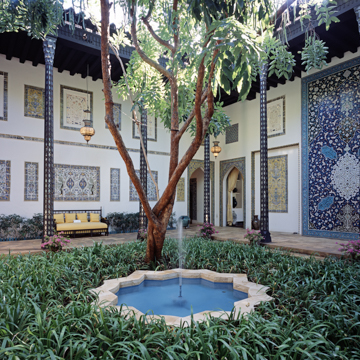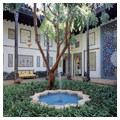Like a chapter from The Lifestyles of the Rich and Famous, Shangri-La offers an up close and personal opportunity to experience one of the nation's most exotic and tasteful country houses. Conceived by “the world's richest girl” when she was but a twenty-three-year-old newlywed, this oceanfront house follows in the tradition of its lavish East Coast counterparts, but does so with a distinctive flair. Predominently Islamic in character, the house serves as a backdrop for an eclectic collection of architectural elements and objets d'art gathered across the globe, from Moorish Spain to Mughal India. These range from the dining room lanai's double-Ionic capitals of Persepolis to the playhouse's liberal interpretation of the Chihil Sutun in Isfahan. Persian tile work, hand-carved Moroccan ceilings, fountains, mirrored columns, and stained glass bedazzle the eye. The 1,128-square-foot living room captivates the viewer with a marble Moorish fireplace, Spanish tole cathedral lanterns, pottery, and a thirteenth-century luster-tile mihrab. The room's entire west wall, a 20 × 12–foot single-pane window, descends at the touch of a button into the basement, allowing the outside in. Other rooms are equally incredible, and include two period rooms, the Damascus and Turkish rooms, and an exquisite marble bedroom and bath. The marble was laid by Thomas Clark and John Koutnik of New York City, who previously had set all the marble in the Chrysler Building. Many of the floors feature hand-sawn sandstone blocks quarried from the ocean in front of the house. The swimming pool is saltwater. Admission may be arranged via the Honolulu Academy of Arts (OA91).
You are here
Doris Duke House, “Shangri La”
If SAH Archipedia has been useful to you, please consider supporting it.
SAH Archipedia tells the story of the United States through its buildings, landscapes, and cities. This freely available resource empowers the public with authoritative knowledge that deepens their understanding and appreciation of the built environment. But the Society of Architectural Historians, which created SAH Archipedia with University of Virginia Press, needs your support to maintain the high-caliber research, writing, photography, cartography, editing, design, and programming that make SAH Archipedia a trusted online resource available to all who value the history of place, heritage tourism, and learning.




















